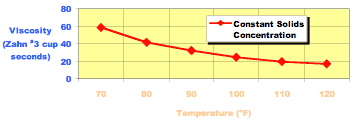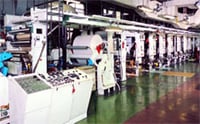When controlling manually, the press operator gave himself a margin for error, as shown by consistently running the viscosity higher than necessary. When the operator was not able to pay as much attention, significantly more material was applied. This extra margin translated directly into excess coating being applied and needless money being wasted. This converter saved $80,000 in coating costs per year plus improved his quality and consistency by changing to Cambridge’s automatic viscosity control.
Temperature: Temperature is also a key factor. It has a marked impact on the relation between viscosity and the solids concentration in the ink or coating, as shown in Exhitbit 3.
 Exhibit 3: Viscosity, Temperature and Solids Concentration
Exhibit 3: Viscosity, Temperature and Solids Concentration
It would be great if the line of constant solids concentration were horizontal in this picture. This would mean viscosity could be controlled without worrying about temperature! Unfortunately, it is not. It has the characteristic curve-shape shown. Whenever the ink or coating temperature varies due to changes in the press room temperature, the viscosity must be changed appropriately to maintain constant percent solids. If you are above the line, excess ink or coating material is being applied and money wasted; if below, inadequate coat weights result.
The color lab might be at 75°F, for instance. Based on that, they might tell the pressman to maintain a viscosity of 50 cup seconds on a #3 Zahn cup to maintain the targeted coat weight or color concentration. In the pressroom the press might also be at 75°F at start-up as well, or 50 seconds is fine. After 10 minutes of operation, however, the press might heat-up to 80°F, and after ½ hour might be 85 or 90°F. At these raised temperatures, the viscosity to keep the correct solids concentration drops to 37 or 32 cup seconds. If the viscosity set-point is not temperature-corrected, you are giving away money!
This can be managed a couple of ways: managing absolute temperature throughout the press equipment, process fluids and pressroom; or incorporate temperature-compensation into the viscosity measurement. With today’s electronics and software, temperature compensation is easily accomplished.
Color Consistency: Color consistency and viscosity are also related. Color consistency is influenced by a number of factors including color density, anilox volume, ink transfer, web substrate characteristics, doctor blade use and characteristics, as well as ink viscosity. Representative results show viscosity control is important to color consistency.

All press equipment, including viscosity control systems, need to be much more reliable, require significantly less maintenance, enable shorter make-ready times, and be able to operate in a world where pressman skills are decreasing.
Known for innovation in viscosity measurement and control, Cambridge Viscosity specializes in the industry's most accurate, reliable, and easy-to-use viscometers for research laboratories and process environments.
Cambridge Viscosity, Inc.
50 Redfield St, Suite 204
Boston, MA 02122 USA
781 393-6500
Email: Sales@CambridgeViscosity.com